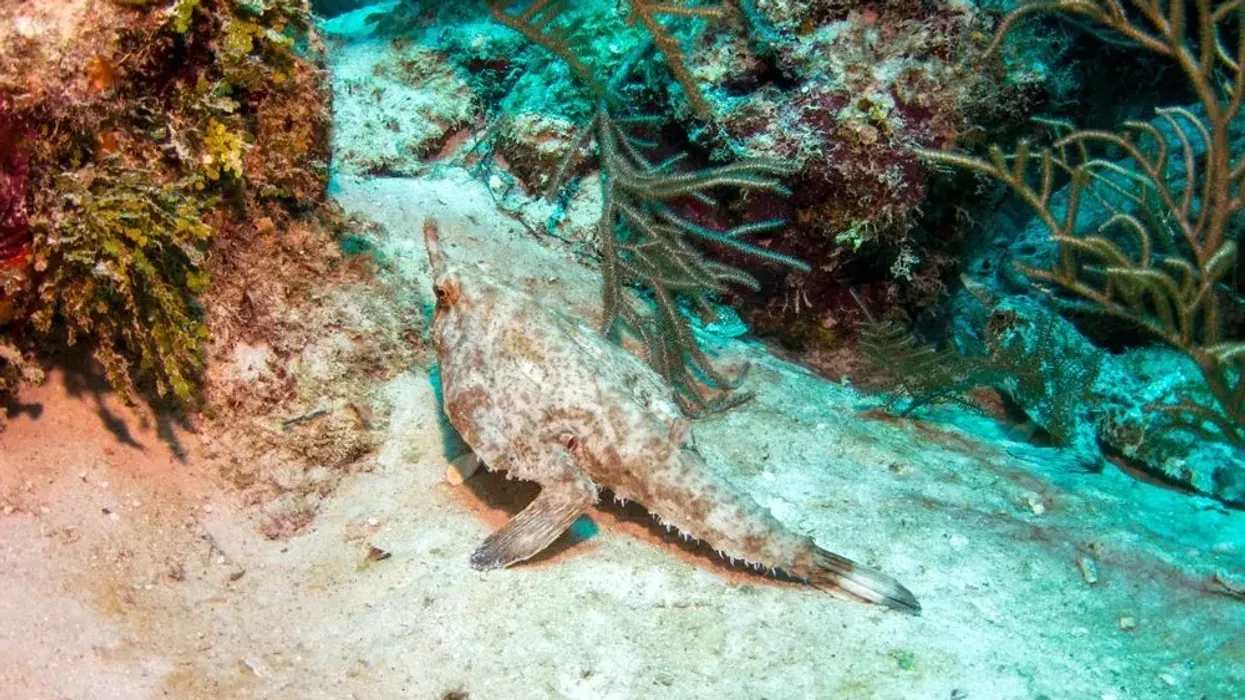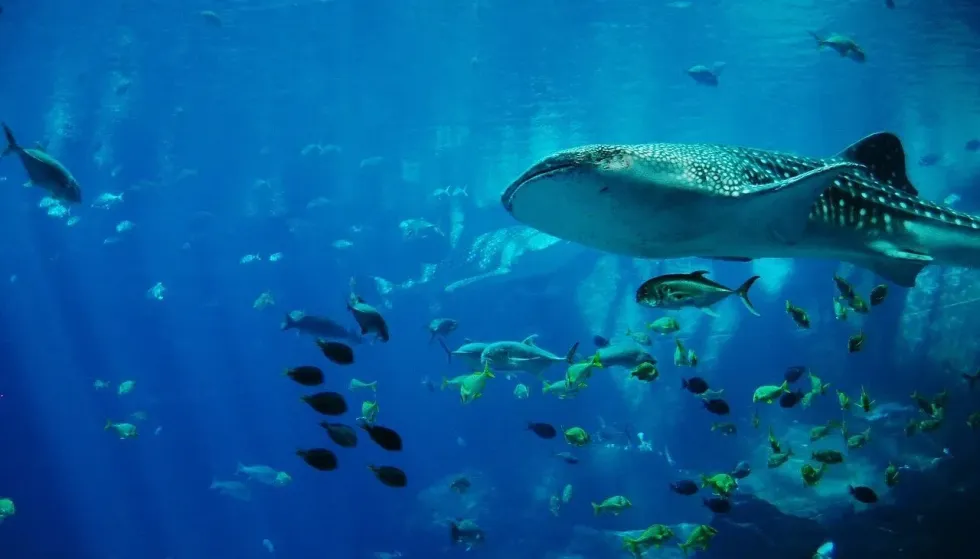Australian ghostsharks (Callorhinchus milii) often known as elephant fish are a distant relative of sharks and rays. It is often misspelled as 'Callorhynchus milii' in many cases.
This cartilaginous marine fish species, belonging to the family Callorhinchidae, is found in southern Australia and New Zealand. Their name was first explained by Bory de Saint-Vincent, in 1823. The Callorhinchus genus, species Milli, is derived from the Greek word 'kalo', meaning 'beautiful', and 'rhyngchos', meaning 'snout'.
The male Australian ghostshark reaches its sexual maturity at the age range of three years, whereas, the female age range is between four to five years. The distribution of these chimaera fish ranges in deep sea waters.
This species of marine fish is known to have a long and sharp spinal cord along the length of its body, which is venomous to humans and other prey.
Commercial fishermen need to complete necessary reports each time during their fishing trip, in order to keep an eye on the distribution of these animals.
After consulting the fisheries every year, the organization of AFMA decides about how much fishing can be permitted given the range of its distribution. These fish make the popular dish named fish and chips in different countries.
If you like this article, check out the other articles on sawback angelshark and Pacific angelshark.
Australian Ghostshark Interesting Facts
What type of animal is an Australian ghostshark?
An Australian ghostshark is a kind of shark.
What class of animal does an Australian ghostshark belong to?
Australian ghostsharks belong to the class called Chondrichthyes.
How many Australian ghostsharks are there in the world?
The exact number of this species of shark has not been listed.
Where does an Australian ghostshark live?
Australian ghostsharks, also known as elephant sharks, inhabit southern Australia and New Zealand. In Australia, they are found in regions including Tasmania and the South East Cape, and in New Zealand, they are found in Kaipara Harbour. They are mostly native to the depths of the southern Pacific Ocean.
What is an Australian ghostshark's habitat?
The Australian ghostshark lives in cool temperatures at a depth of 656 ft (200 m). During the mating season, these sharks often migrate to inshore bays and estuaries.
Who do Australian ghostsharks live with?
Australian ghostsharks or elephant sharks are solitary animals. They are observed mostly to live on their own.
How long does an Australian ghostshark live?
The lifespan of the Australian ghostshark is around 10-15 years.
How do they reproduce?
Australian ghostsharks (Callorhinchus milii) are oviparous in nature. Females during the breeding process move inshore to lay eggs.
The males reach sexual maturity at the age of three, whereas, the females range between four to five years of age. Males have retractable copulation organs located near the pelvic fin. They have lobes shaped like frills and also a globular gland.
The spawning season begins in the month of February and over the weeks, the breeding pairs deposit their eggs on sandy or muddy beds, near the mouth of the river. The egg cases are golden-yellow in color and the incubation period takes around eight months.
During the incubation period, the Australian ghostshark baby feeds on the yolk of the egg. The egg is encapsulated in a leathery, flat elongated case. These cases are 10 in (25 cm) in length and 4 in (10 cm) in breadth.
Before hatching, the color of the egg cases turns black or brown. After hatching from the egg cases, they remain in shallow water after their birth. As they grow older, these sharks move to a greater ocean depth.
What is their conservation status?
The Australian ghostshark (Callorhinchus milii) has the status Least Concern under the IUCN Red List. This elephant fish is considered a target fishery species.
In order to keep a track of how many of these fish are caught, fishermen need to fill up a report whenever any of these cartilaginous fish species is caught. The New Zealand Department of Conservation has given the status of this shark species as Not Threatened with the remark Conservation dependent, increasing.
Australian Ghostshark Fun Facts
What do Australian ghostsharks look like?
The ghostshark or elephant fish is a silverfish that has dark markings on its body. The body is elongated and torpedo-shaped. Their body is very smooth and the color ranges from pale blue, black, and brownish gray.
They have two dorsal fins that are triangular in shape and large pectoral fins. They also have a large and high set of eyes and a single gill opening near the pectoral fin.
Their body is almost scaleless. They have an exceptionally large head with a club-like structure at the end of their snout. The snout is filled with numerous pores that help them to detect movements.
The male has a larger snout than the female. The eyes have a greenish glow because of a reflective tissue that helps them see things under very low light conditions. Elephant fish have big nostrils and large teeth.
The tail fin is divided into two lobes, the upper being bigger than the lower one. They use pectoral fins for movement.
The dorsal fin is located at the end of its tail. They have a long spine which is located in the anterior part of the first dorsal fin. Their spine is considered dangerous and fishermen need to be careful while catching it.

How cute are they?
The elephant fish, also known as whitefish (Callorhinchus milii), is a ghastly-looking fish. The fish has a long and flattened snout which helps them to look for their prey.
The snout also has numerous pores which helps them detect any kind of movement or faint electrical impulse. Their large pair of eyes have a greenish glow which makes them look quite bizarre. They also have a large head with huge nostrils and a silver-colored polished body.
How do they communicate?
The elephant fish, also known as reperepe, detects movements with pores situated on its club-shaped snout. They also have exceptionally large eyes situated on their head which gives them visual cues. However, not much is known about how they communicate with each other.
How big is an Australian ghostshark?
Elephant fish males are 1.6 ft (50 cm) in length, whereas females are 2.3 ft (70 cm) in length. The female whitefish is larger than the male.
How fast can an Australian ghostshark swim?
While there is no exact verifiable data on the speed of an Australian ghostshark, a conservative estimate can be made. While the speed of a shark depends upon the species, an average shark can swim at a speed of around 5 mph (8 kph).
How much does an Australian ghostshark weigh?
A typical elephant fish or Australian ghostshark (Callorhinchus milii) weighs around 7-9 lb (3-4 kg).
What are the male and female names of the species?
No specific names have been attributed to the male and female elephant fish species.
What would you call a baby Australian ghostshark?
A baby elephant shark is called a pup.
What do they eat?
The elephant fish, whose scientific name is Callorhinchus milii, feeds on animals at the depth of the ocean. Their diet consists of mollusks, worms, and shellfish. This species of a distant cousin of rays of Australia, often become food to other sharks and big fish.
Are they dangerous?
The ghostshark (Callorhinchus milii) is a distant relative of sharks rays and is known to have a dangerously sharp spine along the length of theirs body. It has the reputation of being venomous. This species of chimaera fish use their spine to protect themselves from humans and other predators living in the depth of the ocean.
Would they make a good pet?
Ghostsharks, a distant relative of sharks and rays, are known to have a sharp spine along the length of their body which makes them dangerous as it is known to be venomous. The elephant fish inhabits the depths of the South Pacific Ocean and they are also migratory in nature.
They move to bays and estuaries during the breeding season. All these factors indicate that Callorhinchus milii are not fit to be kept as pets.
Did you know...
Elephant shark pups are 6 in (15 cm) in length.
The ghostshark is a distant relative of sharks and rays that range in the South Pacific waters of New Zealand and southern Australia.
The scientific name, Callorhinchus milli, was first explained by Bory de Saint-Vincent in 1823.
How did Australian ghostsharks get their name?
Australian ghostsharks are known by many different names, namely elephant fish, whitefish, and makorepe. They were first described by Bory de Saint-Vincent in 1823.
Even though they are related to sharks, they genetically diverged from them four million years ago. The genus name Callorhinchus is derived from the Greek word 'kalos' which means 'beautiful'.
The word 'rhyngchos' meaning 'snout' is based on the club-shaped snout these marine fish have.
These fish are native to southern Australia and the New Zealand region, and the South Pacific water contributes to a part of its name. Moreover, the pale skin color of these ghastly-looking fish and black eyes with a greenish tinge make these marine fish extremely mysterious for which it has been called ghostshark.
Are Australian ghostsharks endangered?
Australian ghostsharks, distant relatives of rays of Australia, is of Least Concern as declared by the IUCN Red List. These fish are a target of commercial fishing in Australia and New Zealand. However, to keep a check on its distribution range, fishermen are required to fill reports for each of their fishing grounds.
Here at Kidadl, we have carefully created lots of interesting family-friendly animal facts for everyone to discover! Learn more about some other fish from our reef shark facts and blacktip shark facts pages.
You can even occupy yourself at home by coloring in one of our free printable Australian ghostshark coloring pages.










